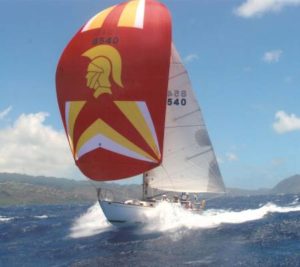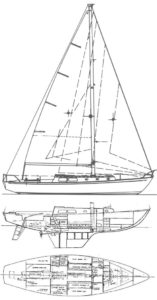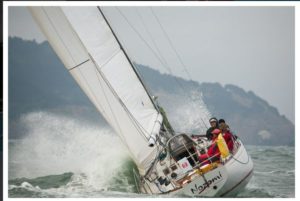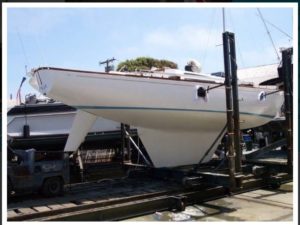
As marvelous as she is, unless steps are taken, the 55 year-old Cal40 will slowly but surely become irrelevant.
Listen up, all you Cal 40 owners and racers: We have nothing but deep love and true respect for all you do, and what you represent.
But, we have two serious marine design words for you all: “It’s time.”
Over the past several months, we have been tinkering with several questions for cruisers/racers for the California, Oregon and Washington coasts. Not everyone realizes how a fertile the waters of the western U.S. have been for yacht innovation. But everything from America’s Cup boats to Bill Lee’s ultra-light TransPac racing sleds have flourished in these open waters that are lucky enough to have the people with the means to race on them in style and speed.
One of the most iconic west-coast craft is, of course, the Cal 40. Starting from around 1963 to something like 1971 about 160 of these super-light, super-simple 40-footers were built. And amazingly, most are still raced, cruised and loved to this day. It’s a hot topic, even now, what Cal 40 owners do to their boats, how they address the yacht’s issues. And what gets spent to support the residual values. Cal 40 restorations are big deals.
We old-boat nerds love that.
So, while we so respect the dedication for the wholesome values of these marvelous boats, we have to be honest about what a career in finessing designs from years past has taught us about keeping older designs relevant: The Cal40, as she is configured today, is blithely sailing into dangerous design shoals.
We’ve seen it time and time again with class after class: Disappointing use of materials, poorly designed rigs, kooky cockpit ergonomics, and inappropriate mechanical choices. It’s so easy to “restore” a great old boat into a miserable mash-up of old and new, like the newly resuscitated Q class: a once vibrant design inbred into bitchy show poodles that secretly scare the sensible people.
What makes the Cal 40’s current walk to irrelevance all the more heartbreaking, is how much this boat still has to offer. It has been said that it is hard to grasp the significance of C. William Lapworth’s original Cal 40 design. And that is totally true. Even 55 years later, in an age of computer models and artificial intelligence, the basic hull shape and layout of this vessel is still fabulous.
What’s more, a package of reasonable upgrades could be easily and cheaply spun up to bring this boat fully into the 21st century. And reinvent a platform that brings all the wholesome principles of this boat into the contemporary idiom.
So with all due respect, here’s what seriously needs to get done to keep the Cal 40 serious.
The Rig:

Innovative in its day, but 55 years later, such short, overlapping sail plans are slow, costly and dangerous.
Folks, just step back and truly look at the dangerous, going-on-50-year-old, low-aspect main, and overlapping headsail sail plan of the Cal 40. How anybody argues that a boat that amateurs routinely sail hundreds of miles offshore would — or should be allowed to — carry this out-of-date rig is a serious question.
By all means, lets count the potential points of extreme rig failure here, when a fully powered-up radial spinnaker gets set: Spin pole, afterguys, foreguy, the way-too-long boom. And that assumes everything is done right. Knock down, crash gybe, dismasting — what are we talking about here?
What makes the Cal 40’s rig that much more ludicrous, is how easily a modern sail plan could be retrofitted into this marvelous design. A reasonably-cheap-to-purchase modern rig could be crafted out of composites for lighter weight aloft. And would feature a fractionally-rigged spar about 8 to 10 feet taller, that would allow for a dramatically shorter boom and probably more sail area. That would allow for a non-overlapping headsail to be rigged from a fore-stay, placed two lovely feet aft of the bow, and furled with an under-deck roller-furler. This more-efficient rig would employ swept spreaders to eliminate dopey running backstays, while also opening up the foredeck for a much safer, simpler, more powerful, taller asymmetrical spinnaker experience: an A-sail that could be easily managed with another roller furler.
Hour-glassed spinnakers wrapped around the forestay, dangerous bald-headed headsail changes, and not to mention getting one’s brains bashed out in a blown gybe, would be nothing but bar talk.
Considering how easily this lovely Lapworth hull design could adapt to the hotter sailing angles that this modern rig require, in the reaching conditions Cal 40’s mostly race in, our Cal “4040” modern rig would be safer, faster and cheaper.
Cockpit Ergonomics.
Is there a picture of a Cal 40 under way without at least one person perched on some random bit of deck, side railing or cabin top? And what is up with the tiny after-market helm wheel that requires the driver to stand in front of the stupid thing to steer?
What’s nutty about the cramped living on the Cal 40 is how simple a serious cockpit reboot would be, assuming we’ve dumped the dumb rig and gotten rid of the dangerously long boom.
A simple, beefy traveller would run on the bridgedeck, and a widened cockpit could allow for a simple hard dodger for shade and weather protection. All that would open the space for a real wheel and comfortable positions to skipper and crew.
Besides a making the boat more pleasant and safer to sail, the upgraded Cal 4040 cockpit would be a revelation to use short handed. Imagine the number of boats racing in this class if one could safely pull a TransPac with just a crew of two?
New Foils for a Better Racing Rule.
Messing with foils, particularly in older boats, is never trivial. But compared to the cost and complexity of a new vessel, investing in new foils does make sense for the Cal 40.
The basic hull is really that good.
First, we would drop the hilariously out of date spade rudder, that has grown to becoming its own maintenance art form in this fleet. And swap in a modern strong and efficient lean steering foil. That would make this boat easier to drive and more durable in a collision.
Next, we would do away with the out-of-date keel and fit in a modern efficient foil that decreases the wetted surface and lowers the center of gravity. This would require some glass work on the bottom and the internal structure — it’s not just an “unbolt/rebolt” proposition. But the build is not that complex and the gain in performance and “feel” would be huge.
Both would dramatically improve light air performance. And make the boat beefier in the heavy stuff. After that, we would refair the bottom, avoid heavy systems like air conditioning or other weighty tools, and then do … exactly nothing else. That’s it. That’s all that’s needed. A new rig, a reworked cockpit and new foils. And for far less than a new boat, this storied vessel would be set for another 50 years.
Rating the “Cal 4040.”
There is, however, one last bit of boat geekery required: Measuring the new Cal 4040 carefully under a modern, subtle racing rule, similar to the ORR. The right rating would be careful to not penalize the existing Cal 40 fleet. But still give owners an upgrade path that creates the incentive to move to new materials.
Once rated properly, we doubt anybody but the experts would notice the side by side difference between the original Cal 40 and the upgraded Cal 4040. That is, until anybody sailed the newer boat. Then the glory of this faster, lighter and safer modern classic would be clear to all.
Plus, think of how proud C. William Lapworth would be that, a half-century later, so many sailors respected his good judgement, that they understood that he would have drawn the exact same rig, cockpit and foils if he could have.
Why wouldn’t an owner of one of Lapworth’s best boats not make his dream Cal 40 real?

